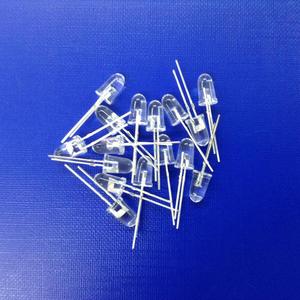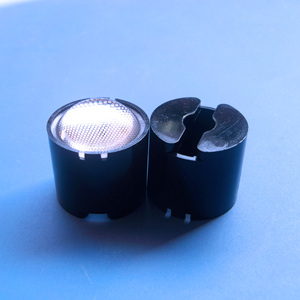(24 products available)



























































































Narrow beam IR LED lights have different applications, ranging from simple circuit boards to complex lighting systems. Here are some of the types of narrow-beam infrared LEDs:
Semiconductor Laser IR LED
This type of narrow beam IR LED is known for its high optical output power. It is popular in applications like optical data communication, laser lighting, laser range finders, and laser printing. It is mostly used where a narrow beam of infrared light is required. These IR LEDs are further divided into;
1. Coherent and Incoherent IR LEDs:
The coherent infrared LEDs emit light with waves that are in phase. The LEDs have beams with low divergence, making them suitable for applications like interferometry. On the other hand, incoherent LEDs produce light with waves that are not in phase. They have beams with high divergence, and their application areas include lighting and heating.
2. Diode and Diode-Pumped Solid IR LED:
The diode IR LEDs are made of semiconductor diodes. They produce light when electric current flows through the device. Solid-diode pumped IR LEDs use a solid-state laser diode to pump the gain medium. The pump process leads to the production of infrared laser light.
Infrared LED
This type of narrow beam LED comes in different sizes and package configurations. It has a lower optical output power than the laser diode. The infrared LED is popular in remote controls, indicator lights, and simple lighting applications.
Narrow beam infrared (IR) LEDs have a beam angle of fewer than 30 degrees. They are widely used for various applications, including lighting, signaling, and illumination. Their features and functions include:
High Intensity
Narrow beam IR LEDs are designed to produce a high intensity of light. The design concentrates the light output in a specific direction, resulting in a more powerful illumination. This makes them suitable for applications requiring long-distance illumination. For instance, these LEDs are used in CCTV cameras, search and rescue operation lights, and other security lighting systems.
High Efficiency
These LEDs have a high luminous efficiency. This means a significant portion of the input power is converted into light output. The efficiency leads to less energy wastage and lower operational costs. High efficiency makes narrow beam infrared LEDs suitable for battery-powered devices. The low power consumption helps to extend the device's battery life.
Durability and Long Lifespan
Narrow beam IR LEDs are durable and have a long operational lifespan. They are constructed with robust materials that can withstand harsh environmental conditions. Also, they have an expected operational lifespan of up to 50,000 hours. The durability and longevity of these LEDs reduce the frequency of replacement, which lowers maintenance costs.
Low Power Consumption
Narrow beam IR LEDs have low power consumption. This means that they require less electrical power to operate. Low power consumption is beneficial for applications that rely on portable battery packs. The LED's ability to consume less power leads to extended battery life and enhanced device portability.
Compact Size
Narrow beam infrared LEDs have a compact size. This allows integration into small devices and electronic circuits. The small footprint design is beneficial in applications where space is limited. For instance, in remote controls, mini surveillance cameras, and small electronic gadgets.
Customizable Wavelength
These LEDs can be designed to emit infrared light at different wavelengths. The wavelength customization is important since some wavelengths penetrate darkness with minimal interference. Additionally, specific wavelengths are more suitable for various applications. For instance, 850nm IR LEDs are popular for surveillance and security applications.
Thermal Management
Narrow beam infrared LEDs are designed with advanced thermal management techniques. This ensures stable performance and high efficiency. The thermal management reduces the risk of overheating, which can damage the LED. It also helps to maintain a consistent light output and increase the LED's lifespan.
While narrow beam IR LEDs have distinct applications, there are various other scenarios where they are extensively used. Here are some common usage scenarios:
Covert Surveillance
Covert surveillance systems incorporate narrow beam infrared LEDs in their cameras. The cameras capture images and videos in complete darkness. The systems use the LEDs to transmit light that is invisible to the naked eyes. As a result, they can monitor activities without drawing attention. This way, they can gather intelligence information without exposing themselves to risks.
Wildlife Observation
Researchers and wildlife enthusiasts use narrow beam IR LEDs in night vision devices. The night vision devices help them to observe and study nocturnal animals. The IR LEDs produce light that is undetectable by animals. Hence, they can conduct their studies without interfering with the natural behavior of the animals.
Search and Rescue Operations
Narrow beam IR LEDs are used in SAR teams. The teams use the LEDs to create a bright light source for aerial view when they are in dark or low-visibility conditions. The narrow beam IR LEDs are also used in personal distress signals. These signals emit a bright beam that can be located by rescue personnel in emergency situations.
Smart Home Devices
Narrow beam IR LEDs are used in various smart home devices. For instance, they are used in smart doorbells, security cameras and motion sensors. The LEDs enhance the devices' functionality. They enable them to capture images and detect motion in dark environments. This provides an additional security layer to the homeowners.
Augmented Reality
AR devices use narrow beam IR LEDs for head tracking. The LEDs illuminate the user's face and other head components. This enables the devices' sensors to detect and track the movements accurately. As a result, the users can enjoy a more immersive experience.
Gesture Recognition
Some electronic devices incorporate narrow beam IR LEDs in their gesture recognition systems. The LEDs create a dot pattern on the user's hand. The sensors then detect the pattern and interpret it as specific commands. This allows users to control devices with hand gestures in dark or dimly lit environments.
When purchasing narrow beam IR LEDs for wholesale, buyers should consider several factors to ensure they are making the right purchase. Here are some of them:
Wavelength
Narrow beam infrared LEDs have different wavelengths. The LEDs have different applications, and some wavelengths are better suited for specific applications. For instance, LEDs with a wavelength of 850nm are commonly used for surveillance. Buyers should get wavelengths that are suitable for their intended use.
Power Output
Another factor buyers should consider when getting narrow beam IR LED is power output. The power output is measured in milliwatts. The power output determines the brightness and the intensity of the light. Ideally, the higher the power output, the better. A higher power output will result in a brighter illumination. Business owners should get a power output that is suitable for their application needs.
Beam Angle
Different narrow beam IR LEDs have different beam angles. The beam angle determines the light distribution. Buyers should get LEDs with a beam angle that is suitable for their application needs. For instance, a 10-degree beam angle is suitable for long-range illumination. On the other hand, a 30-degree beam angle is suitable for medium-range illumination.
Thermal Management
Infrared LEDs produce heat when they are in operation. When the heat is not properly managed it can affect the performance of the LED. Therefore, buyers should look for an LED that has a proper thermal management system. This will ensure the device operates efficiently.
Quality and Reliability
Business owners should look for quality and reliable narrow beam IR LEDs from a reputable manufacturer. They can check the reviews and testimonials of the manufacturer to ensure they are getting quality products.
Q1: What are the main applications of Narrow Beam IR LED?
A1: Narrow Beam IR LEDs are mainly used in various applications such as; remote controls, surveillance cameras, night vision devices, and electronic panels.
Q2: What is the difference between a laser and an LED?
A2: The main difference between an LED and a laser is in the way light is produced. The light produced by LEDs is diffused in all directions, while lasers produce light in a focused beam.
Q3: What are the benefits of using infrared lighting?
A3: Some of the benefits of using infrared lighting include; energy efficiency, versatility, and increased visibility in dark environments.
Q4: What does IR stand for in LED?
A4: IR stands for infrared. Infrared light is a part of the electromagnetic spectrum.